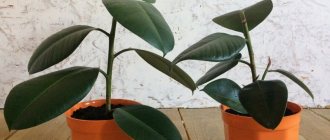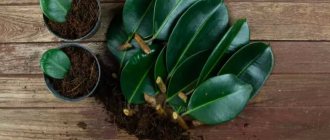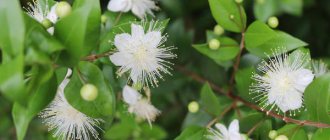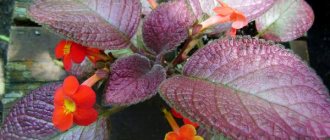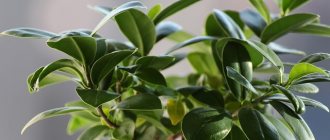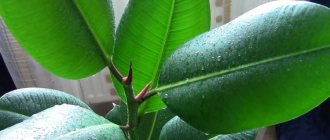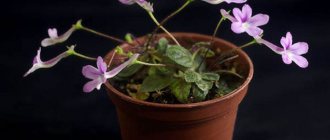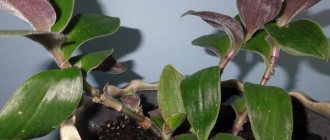Botanical description and characteristics of the plant
Ficus rubber or ficus elastica (lat. Ficus elastica) is a perennial plant of the Mulberry family.
The thick sap of the plant contains large quantities of rubber, which is a raw material for the production of rubber. Thanks to this, the species received its name. The plant was once cultivated on an industrial scale. The juice helps the ficus “self-medicate”: cuts and wounds quickly heal. In its natural environment, rubber ficus is common in the tropical forests of northeastern India and southern Indonesia. The appearance of a ficus growing in its homeland is significantly different from indoors. Thus, wild ficus is capable of reaching a height of 30-60 meters. As a single-trunk tree grows, it develops branches. Aerial roots form on their surface, which take root when they reach the soil surface. This life form of the plant is called banyan.
Living building material
Local residents nicknamed the ficus rubber snake tree due to its numerous hanging roots and even learned to make bridges across the river from the roots of the plant. The plant lives for about 50 years and then dies.
Bridge made of aerial roots of ficus rubbery photo
When grown indoors, the plant can reach a height of 10 m (the average annual growth is 40-45 cm), but by pruning the ficus is limited in growth. Side shoots practically do not appear. If the rubber ficus reaches the ceiling, the top can be cut off without fear. To prevent a large plant from breaking, it will need support.
Living bridge from ficus photo
Decorative in home cultivation are beautiful leathery leaves with a glossy sheen. They are large (up to 30 cm long, about 15 cm wide), in the shape of an oblong oval with a pointed tip. The leaf plates are attached alternately using thick petioles. The surface of the leaf is smooth and shiny, the color is dark green, the central vein is slightly depressed. The reverse side of the sheet is matte, lighter in color. The color of the leaves of many bred varieties is variegated.
Flowering ficus rubber plant
How ficus elastica blooms photo
At home, rubber ficus blooms extremely rarely, however, the flowers are not particularly decorative. Inflorescence-syconium: has the appearance of a capitate or pear-shaped axis with a hole at the top (it is intended for the penetration of pollinators). Syconium is hollow, with small flowers located on the inner wall. If pollination occurs, fig-like fruits will form. They cannot be eaten.
Precautionary measures
In addition to useful rubber, the plant juice contains toxic substances. Its contact with skin or mucous membranes may cause irritation or a severe allergic reaction. If this happens, thoroughly rinse the affected areas with water and seek medical attention if necessary. Therefore, when working with the plant, it is necessary to wear protective gloves. Also limit access to the plant to children and pets.
It is not recommended to grow rubber ficus at home for people suffering from asthma. Substances released by the plant into the air can cause suffocation.
How fast does Ficus rubber grow?
Ficus elastica can be safely classified as a fast-growing house plant: its growth ranges from 40 to 60 cm per year. In natural conditions, the growth rate is much higher: from 120 to 250 cm. Those who want to get a beautiful ficus tree for interior decoration will really enjoy caring for for such a powerful, responsive plant.
How to grow ficus aerial roots. How to grow bonsai from Ficus Microcarpa
Although Ficus Benjamina is considered the most popular when creating a bonsai tree, other species also give good results. For example, Ficus Microcarpa, which is also known by the names: Ginseng (ginseng), blunted, Chinese banyan and even “strangler” - for its ability to entwine surrounding plants with aerial roots and inhibit their growth. The thick trunk of the ficus Microcarpa seems to consist of several intertwined thinner trunks, which attracts bonsai lovers. However, in reality these are thickened aerial roots.
Ginseng for growing bonsai is in many ways even simpler than Ficus Benjamin. To speed up the process of rooting and growth of aerial roots, form a greenhouse over the container with the planted shoot. For example, cover the cutting with a glass jar of suitable size or put a transparent plastic bag over the pot. Every day, open the greenhouse for 20–30 minutes for ventilation.
In July, the ficus Ginseng needs to be replanted. Be sure to shorten the roots by a quarter before planting in new soil.
Ficus Microcarpa needs plenty of sunlight, but direct rays are best avoided. In autumn and winter, provide the plant with fluorescent lamps to keep the daylight hours within 14–16 hours.
Please note that this type of ficus does not like dry hot air. Place the bonsai at a considerable distance from heating devices and heating radiators. Keep the plant away from window sills to protect it from cold drafts.
Do not forget that the leaves of the Ginseng ficus are moderately poisonous. Choose a place for the plant that is inaccessible to children and pets.
The optimal height of a bonsai from the ficus Microcarp is 50 cm. When the tree reaches this size, you can begin to form the crown. As a rule, this occurs in the 3rd–4th year of growth. By this time, the aerial roots will also become quite large. Be sure to prune during growth so that the tree does not stretch upward.
Ficus Microcarpa is incredibly hardy and grows very quickly. Trees appear wherever seeds fall. The plant is found on the roofs of multi-story buildings, on rocks and even in sidewalk cracks.
Do not be alarmed if your Microcarpa ficus begins to shed leaves en masse - this is a characteristic phenomenon for this species. Ginseng's foliage lives for 3 years, after which it falls off, but pretty soon the plant acquires a new crown. And yellowing of the leaves, starting from the lower ones, signals that it is time for the plant to fertilize.
Conditions for growing ficus elastica
Does unpretentious mean boring?
Thanks to its ease of maintenance and unpretentiousness in care, rubber ficus has become the most popular decorative foliage plant since the youth of our grandmothers. It could be found everywhere: in homes, libraries, cinemas, educational and other institutions. Then the plant began to be regarded as bad taste, and the time came for oblivion. In the last 10 years, the popularity of ficus rubber has been gaining momentum again, mainly thanks to the work of Dutch breeders. They pleased us with new varieties that can conquer even the most experienced gardeners.
We are constantly busy and in a hurry to get somewhere, and indoor plants add comfort and elegance to the room. Caring for a plant will not take much time and effort; on the contrary, “communicating with a green friend” will help you relax after a busy day at work.
Lighting: where to put ficus elastica?
In order for the ficus to grow and develop well, you must first choose a suitable place for it. Bright, diffused lighting is required throughout the year. Variegated forms especially need this, but avoid direct sunlight. If it is not possible to place it near an east- or west-facing window, slight shading is acceptable (we place the container with the plant in the back of the room or on the northern window sill). Please note that in shading the growth rate will slow down, over time the leaves will begin to fall from the lower part, and it will become bare.
Also, when choosing a location, avoid drafts and exposure to cold air. In winter, do not place near heating devices or radiators.
Air temperature
The temperature regime will need to be moderately warm. During the period of active growth (spring-mid-autumn), the air temperature should fluctuate between 20-25 °C. Wintering must be cool: from late autumn to spring, maintain the air temperature at 15 °C.
Aftercare
Transplantation will not be very stressful and painful for the plant if the grower follows all the recommendations prescribed in the instructions. A very important stage after transplantation is restoration, during which the flower should be looked after with special care.
Care during the recovery period of the ficus after transplantation involves creating the most gentle conditions for it. These include:
- quite abundant but soft lighting;
- stable air temperature;
- constant air and substrate humidity.
While the plant adapts after transplantation, it needs to be provided with an abundance of soft, diffused light. It is not allowed to place the ficus on the windowsill so that direct sunlight falls on it.
Recovery after transplantation will occur more quickly and comfortably if the room temperature is maintained at a constant temperature of 22-23 degrees Celsius. Drafts, cold and temperature changes are detrimental to the evergreen plants described, so these factors should be carefully avoided.
Dry air is harmful to ficus plants, so it is recommended to spray the plants regularly in hot weather. Some gardeners from time to time spray ficuses with water with the addition of the drug "Epin". It allows the plant to restore its strength after suffering stress, stimulating its intensive development.
If after replanting the ficus has dropped its leaves or even dropped its foliage altogether, there is no need to panic. In most cases, this is a natural reaction to stress. The risk of withering and falling leaves increases many times if the transplant was not done at the most appropriate time - in particular, in winter.
It is recommended to hide small-sized transplanted ficuses under film, setting up an impromptu greenhouse above the pot. In such conditions, plants will recover faster from stress.
To learn how to transplant a ficus from a store, see the video below.
How to care for ficus rubber at home
Ficus rubber plant care at home photo
Watering and spraying
It is necessary to water the rubber ficus as the top layer of soil dries to a depth of 3-4 centimeters. During the warm season, watering is carried out 2-3 times a week, in autumn and winter - approximately once every 7-10 days. The proper level of air humidity in the room is achieved by regularly spraying the plant. With the onset of the cold season, replace spraying by wiping the leaf plates with a damp sponge. The plant should be watered and sprayed with warm and purified water (melt, rain, filtered or settled for at least a day).
Clean and shiny leaves
To maintain a glossy shine, gardeners recommend polishing the leaves with a soft cloth moistened with a decoction of onion peels or non-alcoholic beer.
Feeding
To maintain stable growth and a spectacular appearance of the plant, the ficus will need to be fed throughout the spring and summer. Use complex mineral fertilizers with a high proportion of nitrogen. Prepare the fertilizer in liquid form and apply it every 15 days.
The replanting of the bonsai is complete, but I still want to decorate the bowl in some other way. Bonsai is a Japanese art. But the Japanese borrowed the technology of growing trees on a tray from China. I associate China with old Chinese action films, where monks fought among themselves for some ideas...
Bonsai, oriental, Buddhism: for me they add up to one picture. Buddhist monks who settled down to rest under the crown of an old oriental tree.
Now all that remains is to spray the plant and place it in its permanent place on the windowsill.
Watering and fertilizing
3 days have passed since the transplant. The plant shows no signs that it is unwell. There was no leaf fall. All this time I just sprayed it. Now is the time for watering.
The frequency of watering bonsai depends on the type of plant. But due to the small volume of the pot and special soil, the time between waterings is reduced compared to conventionally grown indoor plants. For example, I water my tree once every 3 days, while Benjamin’s ficus, growing in an ordinary pot in ficus soil, requires my attention only once a week.
You can water your bonsai in different ways. However, watering from a watering can with a narrow neck leads to erosion of the soil, so I choose to shower with settled water at room temperature using a hand-held pump sprayer.
Compared to a regular sprayer, it is much more convenient. The plant needs to be watered for a long time, and the hand does not get tired. The controls are simple. Inflate the air, press the button, lock the button (if necessary) and that’s it. You can also increase or decrease the water flow.
We start watering the bonsai from the top, from the foliage, gradually moving down to the ground. It takes me about half a liter of water to water one plant. Excess water flows into the drainage holes.
A month after transplantation, young leaves continue to grow. The surface of the bare roots gradually dries out and in appearance becomes similar to a trunk, as it should be. The salted moss began to sprout.
Trees growing in nature usually have an extensive root system, which allows them to receive the amount of nutrients necessary for growth. The houseplant has nowhere to get these substances from. Therefore, it needs regular feeding.
Fertilizer for bonsai should contain phosphorus, potassium and nitrogen in ratios depending on the type of plant itself. Fertilizer can be dry (powder, sticks, granules) or liquid.
For my pre-bonsai, I use liquid fertilizer for ficus, diluting it with water in the proportions indicated on the package.
Feeding is carried out once every 2 weeks. Moreover, not only the soil is fertilized, but also the foliage. Before applying fertilizer, the plant must be watered so as not to burn the roots.
Ligature application
The branches of Ficus Benjamin have one feature. Until they reach about three years of age, they remain flexible, then they begin to stiffen. While the branch bends easily, the direction of its growth can be adjusted so that the indoor plant in appearance begins to resemble a centuries-old tree with thick branches bending under its own weight, or even bend the trunk and branches, depending on the chosen bonsai style. For such purposes, a ligature is applied, that is, winding the branches with wire and then bending them. After a few months, the branch gets used to the new position, and after removing the wire it remains bent.
To apply a ligature, you need a soft, usually copper, aluminum or brass wire. In any case, the wire must be made of non-ferrous metal or insulated so that when it comes into contact with water while watering the plant, it does not rust. The diameter of the wire should be 3-4 times less than the thickness of the branch being wrapped, but it should not be too thin to be able to hold the branch in the desired position.
To cut the wire you need pliers (cutters).
You can also use all kinds of sticks, as thick as branches that you plan to bend. This could be a peduncle holder, a Chinese chopstick, a felt-tip pen, a pen, a pencil, and so on. But we will talk about their use a little later.
To begin with, we decide on those branches that will bend. We do not touch branches that are too young and thin for now. I plan to bend the 3 middle branches.
We cut a wire approximately 1.5 times the length of the branch and attach it to the trunk at the base of the branch growth. The ligature is applied from bottom to top in a spiral at an angle of 45° in the direction of growth of the branch to its apex.
There is no need to wrap the wire too tightly. This can lead to restricted sap flow and the tree may die. You also need to ensure that the leaves and shoots growing on the branch do not become tied to it and remain free.
Excess wire is cut off.
The wire-wrapped branch is carefully bent with two fingers (thumb and forefinger), giving the desired direction, starting from the base and gradually moving towards the top. In this case, the wire prevents the branch from returning to its original position.
To facilitate the process of wrapping branches with wire, you can use a stick. Again, cut the wire to the required length. He winds it around the stick (again at an angle of 45°), thus forming a spiral. Leave the end of the wire without bends to attach it to the branch. Remove the wire from the stick. And we wrap the branch with the already obtained spiral.
This way I bent 3 branches. The tree has now become more compact; it almost does not protrude beyond the boundaries of the bowl. It is also necessary to take into account that after removing the ligature, the branches straighten slightly.
The wire will remain on the tree for 3 to 6 months. It all depends on the thickness of the branches, the strength and growth rate of the plant. Next, we continue to care for the plant as usual. You just need to make sure that the wire does not dig into the branches. If necessary, it can be replaced.
A month after applying the ligature, it is worth checking the general condition of the plant. The ficus is now in the stage of active growth, that is, not only new leaves are growing, but also the branches are thickening. And the moss is slowly growing. If the wire crashes into a branch, it will significantly spoil the appearance of the tree, and this is of no use to us at all. Therefore, if necessary, we weaken the wire winding or completely replace it with new wire.
In my case, the wire does not fit tightly to the branches; you can not change it for now, but continue to monitor the growth of the plant.
Growing aerial roots
Since the ficus feels excellent, we can perform the following procedure on it, I would say surgical.
Ficus benjamina has one interesting property. It is capable of growing roots on branches. Usually this property is used as one of the methods of propagation by so-called air layering. I want to grow aerial roots on one of the lower branches of the tree.
First, I will cover the surface of the pot with stretch film to prevent the soil from spilling.
Now I choose a place from which aerial roots should develop. If leaves grow on it, they need to be cut off. Don't forget about gloves! We take a sharp knife, I have a mounting knife. A razor blade will also work. Disinfect the instrument. I lay the plant down more comfortably and make small cuts in the lower part of the branch, as if scratching it. Then I carefully remove the top layer of wood. If the knife is sharp, this is done very simply.
Using a cotton pad soaked in water, I stop the movement of the milky juice. I sprinkle the cut with a small amount of root former. It is necessary to wrap the branch with wet sphagnum moss on all sides, thus creating a greenhouse effect, that is, providing favorable conditions for the formation of roots - warmth and moisture.
I fix the moss with stretch film.
Next, you need to make sure that the sphagnum always remains moist. As soon as it begins to lighten (that is, dries), the film needs to be unwound, and the moss itself should be sprayed from all sides. As a rule, this is done every three times. On average, roots form within 2 months.
A tree with numerous aerial roots on the trunk and branches is called banyuyan. After some time, the aerial roots reach the ground, take root and become additional trunks. One such tree can have several hundred trunks and occupy a significant area. In India, the banyan tree is considered a sacred tree. It is plants from the genus Ficus that belong to the banyan trees. They look simply amazing!
... 2 months have passed. I want to see what happens to the aerial roots. To do this, I carefully unwind the film and remove the moss.
During this time, the cut on the branch became longer and several young roots formed. If they do not die, it will take them several years until they grow to the ground and turn into additional stems.
Removing the ligature
It's also time to check what happens to the applied ligature. Experts recommend not unwinding the wire, but cutting it with special cutters so as not to damage the side stems and leaves. But I don’t have such a tool, so I carefully, but still unwind the wire.
After 3 months of being under the wire, the branches took the desired position, so I don’t need to re-apply the ligature. Basically, I'm happy with the result...
... It’s now the end of November, that is, about 2 more months have passed since the ligature was removed. The plant is in good condition. It looks pretty lively. The branches whose tops were pruned are fine. Those branches that were bent remained in the desired position. The aerial roots have grown slightly. The planted moss continues to grow over the surface of the bowl.
Now the plant is going dormant. Until next spring I will not do anything with it, I will give it a little rest.
Starting from the end of February - beginning of March I will continue shaping the bonsai. It’s difficult to predict my actions now. But, most likely, there will be no replanting with root pruning next year. Perhaps I’ll try to grow aerial roots so that there are more of them. I also want to turn the tops of the top two branches out a little, because they are now overlapping each other. Well, in the spring the plant will begin to grow again, so trimming the crown cannot be avoided.
This is how, gradually, year after year, you can independently grow a real Japanese bonsai from an ordinary indoor plant...
We recommend reading: - Ficus Benjamin for "dummies" - Ficus Benjamin for "amateurs" - Ficus Benjamin for "advanced". How to grow bonsai
How to form ficus rubbery
Formation of rubber ficus at home photo
To form a beautiful compact crown and ensure dense leaf growth, ficus should be pruned. Carry out the procedure in early spring, armed with a sharp sterile knife or scalpel. Do not forget to wash the tool with warm water after use.
How to make a ficus branch?
As a rule, pruning the top does not lead to the growth of side shoots, but only activates the upper growth point. The desired result is achieved by pruning the top 5-6 internodes; the height of the plant should not be less than 70 cm.
To form a branching bush, you can use the following techniques:
- Tilt the top of the young ficus down as far as possible and secure it with a cord. The bud that is highest will become active and will sprout. Then the top can be “released”.
- Try piercing the central shoot with a needle, do this to a depth of 1/3 of the diameter. You can make several punctures, moving from the top down. This procedure will slow down the growth of the top.
- It is also useful to remove weak, thin shoots so that the remaining ones are more powerful.
After removing excess branches or pruning, juice appears in the wounds. Wipe it off carefully to prevent rotting and infection of the wound.
A month after pruning, be sure to fertilize the ficus with complex fertilizer (for example, Kemira Lux) according to the instructions in order to provide additional nutrition to the weakened plant.
For “lazy” gardeners, a simple way to get a compact, dense bush is perfect: just plant 3-5 plants in one pot, and when they reach the desired height, pierce the tops of the shoots so that they stop growing. This will be enough to get the perfect crown of a handsome ficus without any hassle.
How to transplant?
A couple of days before transplanting, the ficus is not watered. This will allow the earthen coma to dry out a little and become lighter, which will reduce the load on the roots and simplify replanting at home.
We should not forget that new plants, after being purchased in a store, are replanted only after 2-3 weeks. During this period of time, the ficus will have time to adapt to unusual conditions, and the grower will have the opportunity to objectively assess its condition.
When preparing to transplant a ficus, you should equip yourself with the following auxiliary tools and materials:
- old newspapers;
- small spatula for flowers;
- sharp scissors (for trimming damaged roots and shoots);
- watering can with warm, settled water.
To make the procedure easier, the work area is covered with newspapers. An empty basin is placed nearby to dump excess substrate or old soil, and tools are laid out - scissors, a spatula or scoop, a watering can.
Immediately before the procedure, a new pot is prepared. A layer of prepared and treated substrate is poured into it over the drainage layer, filling about a third of the container. Then, holding the ficus by the root neck, carefully remove it from the old pot along with a lump of earth. If the plant is difficult to remove, you can gently tap the wall of the pot from the outside. In very difficult cases, if the ficus is too large and powerful, you can use a wooden stick, which is used to carefully detach the adhered roots from the walls of the container.
Following all the recommendations for replanting step by step, you should inspect the roots of the flower after extraction. A healthy plant's roots are white, light yellow or beige. When a plant is damaged by pests or pathogens, the roots acquire a reddish-brown, dirty gray, or dark brown hue.
Dry, diseased, damaged or rotten roots that are found should be carefully trimmed to the healthy part, and then the cut area should be powdered with ash or crushed charcoal.
If there are traces of pest damage on the root system, the plant must be thoroughly treated with chemicals - insecticides.
After inspection and treatment, the ficus, together with a lump of earth on the roots, is placed in another pot. Among flower growers, this method is called “transshipment”. In order to transplant the ficus correctly and with the least damage using this method, you need to focus on the center of the pot. The trunk of the tree should be located in the central part of the container.
Next, the pot is completely filled with loose substrate and carefully tamped down on top with a spatula. At the end of the work, the flower is carefully watered with a solution of a root-forming stimulant. When the earthen ball dries out a little, the plant is watered again, but with regular, settled water. The next watering is recommended only after a week, when the tree has taken root a little and regained its strength.
How to trim rubber ficus and form a crown, watch the video:
Ficus tolerates pruning well at any time of the year, but is most responsive to it in late spring and early summer. Experts consider this time to be the most favorable for all types of pruning. Sanitary pruning can be done as needed: remove weak and damaged branches at your convenience.
When working, be sure to wear rubber gloves to protect yourself from the poisonous juice.
Replanting ficus rubber
Replant young ficuses (up to 3 years old) annually, then every 2-3 years. Focus on filling the container with roots. Ficus is a long-liver, and replanting large plants is difficult, so the procedure is often replaced by updating the top layer of the substrate. Remove it to a depth of 4 cm, act carefully so as not to damage the roots. Don’t delay replanting and replacing the top layer of soil - do it in early spring before growth begins.
With each transplant, increase the depth of the container by 5 cm and the diameter by 3-5 cm. If you initially take a large pot, the plant will begin to rapidly grow its root system to the detriment of the development of the above-ground part.
There is nothing complicated about replanting a plant:
- Place a four-centimeter drainage layer at the bottom of the prepared container. You can use expanded clay, pebbles, vermiculite, brick chips or a mixture of them.
- Transfer the ficus together with the earthen clod, and fill the voids with substrate.
Priming
The plant requires light and loose soil. You can purchase a special substrate for ficus plants at a flower shop. If desired, prepare the soil mixture yourself. You will need turf and leaf soil, peat, coarse sand, mix all ingredients in equal proportions.
After replanting, the leaves at the bottom may fall off, but there is no reason to worry. The adaptation period after transplantation lasts about 15 days.
Reproduction of rubber ficus at home
At home, rubber ficus is propagated vegetatively. There are several ways, let's look at each of them in detail.
Propagation of rubber ficus by cuttings
Carry out the procedure in the spring.
- Cut cuttings 10-15 cm long.
- Hold them under running warm water until the milky juice stops flowing.
- Remove the leaves from the bottom, and roll the rest into a tube and secure with an elastic band. This is done to reduce the area of evaporation.
- The process of rooting cuttings of variegated varieties does not always end successfully, so before planting it is better to keep them in a solution of a growth stimulator (Heteroauxin, Kornevin, Epin).
- For rooting, plant the cuttings in a sand-peat mixture.
How to root cuttings of ficus elastica Result of rooting in water photo
It is more reliable to root variegated forms in greenhouses with bottom heating. With some creativity, you can create a greenhouse on a windowsill. Cover each cutting with a cut plastic bottle or glass jar; if the structure turns out to be unreliable, one of the household members may accidentally knock it over.
It is better to wrap each cutting in a plastic bag. Any shelter will need to be raised daily for ventilation. Provide diffused lighting, maintain the air temperature at 25 °C, and water as needed. When new leaves appear, you can plant the cuttings in individual containers with a suitable substrate.
Ficus elastica cuttings rooted in the substrate
Don't try to root leaf cuttings: they will produce roots but never produce shoots. There is even a special term given to this phenomenon: “blind leaves.”
Rooted leaf of ficus rubber plant photo
Rooted leaves will remain healthy for a long time, and then die for no apparent reason. This is an amazing phenomenon that only some plant species are capable of.
Reproduction by layering
Variegated forms of rubber ficus successfully reproduce by layering:
- Make a cut on the stem with a depth of 1/3 of its thickness, insert a match into it so that the edges do not close.
- Wrap the cut area with damp sphagnum moss, additionally wrap it with polyethylene on top and secure the structure with tape or cord.
- As soon as you notice the roots formed through the transparent film, cut off the shoot below the layer along with the roots and plant it in the substrate.
Formation of aerial roots in ficus. Reproduction of ficus benjamina
The easiest way to propagate ficus benjamina is by cuttings; they easily take root in water, in a bright place at almost any time of the year. Just cut any branches you like about 13-15 cm long, remove the two bottom leaves and place in a jar with clean water. To prevent the water from blooming, cover the jar with an opaque cloth. No growth stimulants are needed. Cuttings of this size already have a woody stem, but if you cut a couple of leaves with a still green stem, it will not take root. Ficus benjamina does not reproduce by leaf, and large branches with thick bark take an extremely long time to take root.
If for some reason the plant has become bald in the lower part of the trunk, it is easier to re-root the crown. For this purpose, not cuttings are used, but air layering:
Air layering of Ficus Benjamin On the trunk in the right place, the bark is cut and removed, a strip about 1 cm wide. The trunk in this place is wrapped with sphagnum moss soaked in water (it is secured with a thread only for the convenience of photography)
Air layering of Ficus Benjamin We cut a plastic cup along the walls into two halves (cut the bottom to half and make a hole along the diameter of the trunk) and fix it on the trunk, securing it with tape. We fill the soil and water it.
Air layering of ficus benjamina It is advisable to use a transparent glass so that you can notice the appearance of roots. The soil in the cup needs to be watered regularly, it should not dry out. The roots on this layer appeared after 3 weeks.
Pests of ficus rubber
The plant has strong immunity to disease, but is occasionally damaged by insects. Among them are spider mites, scale insects, thrips, and mealybugs.
Let's take a closer look at the signs of damage and methods of pest control:
- Spider mites are small red-brown insects. It settles on the reverse side of the leaf and leaves secretions in the form of small whitish cobwebs. Small dark spots (traces of tick bites) can be found on the surface of the leaves; soon the leaf plates will begin to turn yellow and fall off. The pest actively reproduces at high temperatures and dry indoor air, so change the conditions under which the plant is kept. Wash the plant under running warm water, carefully treating the back of the leaves. To get rid of the pest, you can use folk remedies: spraying the leaves with tobacco infusion and soap solution (for 1 liter of water we take 50 grams of soap and 100 grams of tobacco dust) or Dalmatian chamomile infusion. After a couple of hours, wash the plant with warm water. If necessary, re-spray after 10 days. Treatment with the insecticidal drug Actellik gives good results.
- Obvious signs of scale insect damage: the appearance of dots, dark spots and a sticky coating on the leaves; the pests themselves form growths in the form of dark tubercles. Moisten a cotton swab with insecticide and remove pests mechanically (carefully wipe the leaves and stem). Then spray the leaves with the same insecticide or a product you prepare yourself (a tobacco-soap solution with the addition of a small amount of denatured alcohol or kerosene).
- Thrips are most often brought into the house with a new plant purchased at a flower shop or from hand. The pest is invisible to the naked eye, so it is better to quarantine the flower after purchase (separate from others). Thrips feed on the sap of the plant, and give themselves away as puncture marks - small dark dots on the leaves. It is necessary to treat with an insecticidal preparation (Confidor, Ankara, Fitoverm, Vertimek).
- The mealybug is a small insect covered with cotton-like pubescence, and it also leaves a discharge similar to lumps of cotton wool. The pest settles in entire colonies on leaves and stems. Soak a cotton pad in ethanol or formic alcohol and thoroughly wipe all parts of the plant. Then treat with onion or garlic infusion with the addition of a soap solution. After a few hours, wash the ficus under a warm shower.
Why do the leaves of rubber ficus turn yellow?
Ficus rubber leaves turn yellow
This happens for a number of reasons:
- Salinization of the substrate, which happens when watering with low-quality water. It is better to replant the plant in new soil and follow the watering recommendations in the future;
- Oversaturation of soil with fertilizers. Do not overfeed the ficus initially, because it will have to be replanted. If the transplant was carried out recently, it is better to save the plant by washing the substrate through top watering. Spill the soil with an amount of water equal to three volumes of the pot;
- The container in which the flower grows is too large. Transplant the ficus into a smaller pot;
- Root rot. The leaves turn yellow and the substrate smells rotten. It is urgent to transplant the plant into fresh soil. Cut off the rotten areas, be sure to treat the cut areas with a fungicide, and disinfect the container.
If the leaves of the ficus rubber plant turn yellow, you now know what to do. The main thing is not to make mistakes in care, and no difficulties will arise.
Useful properties of the plant
Ficus rubber with large, glossy, green or variegated leaves not only fits well into the interior of any room, but also has a number of useful properties. And in Buddhism it is revered as a sacred plant.
The flower purifies the air in the room: benzene, phenol, trichlorethylene and other toxins are processed into sugars and amino acids.
Based on the crushed leaves and juice of the plant, preparations are made for the prevention of cancer, the treatment of fibroids and uterine fibroids, and mastopathy. For arthritis, radiculitis, osteochondrosis and hemorrhoids, apply compresses and lotions from ficus juice.
Ficus rubber: signs and superstitions
There are many beliefs in the world regarding ficus. According to some, it attracts happiness, prosperity and well-being to the home, while according to others, it breaks up couples and dooms women to loneliness.
Buddhists and followers of Ayurveda are confident in the extremely beneficial effects of the plant. Ficus is able to absorb the energy of anxiety, anger, and panic. A soft and peaceful atmosphere will reign in the room, setting you up for tranquility. This is good for both home (apartment) and office, meeting room, or any institution. To enhance the effect, the leaves of the plant should be directed to the west.
From an energy point of view, ficus should not be placed in the central, southern and northern parts of the house. This arrangement does not allow him to show his abilities; on the contrary, negative energy will begin to accumulate in the room.
According to Feng Shui, the plant also has a positive effect. And where you put it, that’s how it will “work”.
- In a spacious room - fortunately, positive emotions and impressions.
- When placed in the corridor or at the entrance to the house, it will protect the household from the evil and negativity of the surrounding world (from ill-wishers, for example).
- In the kitchen - to abundance, in this house no one will go hungry.
- The plant attracts money. Place it in your office or work area, then expect profitable deals, career growth and salary increases.
- Couples dreaming of children are recommended to place the plant in the bedroom. Plant a young ficus in a new pot and place it at the woman’s head. Take care of the plant as if you were caring for your child, then the appearance of the baby in reality will not be long in coming. In the future, the energy of the plant has a beneficial effect on the course of pregnancy and childbirth.
In our culture, ficus has long been considered a muzhegon, “surviving” men from the house. Under no circumstances should it be given to newlyweds or grown by unmarried people. In the first case, the couple will separate, and in the second, the girl will not meet her soulmate.
Ficus can rightfully be called one of the best decorative foliage plants and one should not pay attention to superstitions and signs.
Aerial roots of ficus, what to do. Ficus - disease or aerial roots?
- Messages
Nikita
Participant
Good afternoon Help me to understand. I’ve been growing this beauty for several years now from a small branch and the other day I noticed strange “growths” on its trunk. After googling, I found out that ficus trees are characterized by aerial roots, but I am confused that mine has them not on the lower part of the trunk, but almost on the top. Tell me, does anyone know what this could be? Maybe not roots at all, but some kind of disease? I am very afraid of this - I value the tree. Thank you in advance!
Attachments:
Anna Irk.
Participant
Why do they bother you? On the contrary, such humidity is more preferable for ficus; there is no need to lower it. And she’s not that tall in yours, otherwise it would be like in my photo. It is unlikely that they will grow further; most likely, they will remain the same. Don't worry, this is the absolute norm.
Valery
Participant
Ficus is an interesting plant; many years ago, in order to restore a dying ficus, Ali placed it in an improvised greenhouse (a bag from a winter jacket, with a hole for watering). As a result, over several years, the ficus restored its root system, sprouted a fairly large number of aerial roots, I removed some of these roots, and the other part took root successfully. The result was... I don’t even know what to call this huge structure made from a living plant. I'll send a photo later. So don’t worry, this is normal for plants that love humidity but not overwatering.
Valery
Participant
If airborne measles bother you, remove them. The milky sap will ooze for some time, then it will go away. Lack of moisture - the first signs are the leaves crumbling and the tips of the leaves drying out. Excess moisture, various putrefactive phenomena, moisture is more/less than normal, bright leaves of the required size (each type of ficus has its own characteristics), quite a lot of new shoots at the ends of the branches. And ficuses love well-lit places.
Nikita
Participant
Valery, I have a question about the light. Now the ficus lives on the balcony, but winter is coming and the temperature on it will not rise above 20 degrees. Accordingly, I plan to move it to the room, but the lighting in it is not so good. Is this fraught with something or will it survive the winter normally? Maybe if the temperature fluctuation on the balcony is 15 - 20 plus, then he will be able to overwinter there too?
Varieties of rubber ficus with photos and names
Varieties with monochromatic leaves:
Ficus elastica Abidzhan Ficus elastica Abidzhan photo
Abidzhan - the length of the oval leaf blades is 25 cm, width - 18 cm. When young, the leaves have a dark burgundy, almost beetroot tint, then become deep dark green. The central vein below retains a burgundy hue.
Ficus elastica Melanie Ficus elastica Melany photo
Melanie is a miniature plant. The leaf length is about 15 cm, width - 8 cm. The leaf blades are shiny, dark green in color. The central vein is slightly depressed; on the reverse side they are reddish in color. It is noteworthy that a young bush is capable of branching even without pruning.
Ficus elastica Robusta Ficus elastica 'Robusta' photo
Robusta - the plant has a powerful rhizome, a thick trunk, large and fleshy leaves, which fully justifies the name of the variety (from the English robust - massive, strong, strong). The leaf blades are broadly oval in shape with a pointed tip, which is slightly bent downwards in the same way as the edges. The leaf color is dark green.
Ficus elastica Burgundy Ficus elastica Burgundy photo
Burgundy is an elongated leaf, about 30 cm long and 10 cm wide. The shade is dark burgundy, the petiole is pinkish.
Ficus elastica Black Prince Ficus elastica Black Prince photo
Black Prince - a leaf blade of the same length as the previous variety, the width is about 18 cm. The leaf blade is eggplant-colored, the central part is lighter.
Ficus elastica Decora Ficus elastica Decora photo
Decora – the leaf plate is long (about 30 cm) and wide (about 20 cm). The leaves are almost heart-shaped in shape, forming a groove (both sides of the central vein are bent, like a half-opened book). The color of the leaves is rich green, the vein from the petiole is reddish, and above it is creamy.
